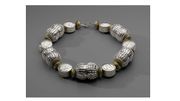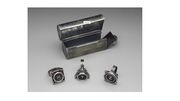Difference between revisions of "Metal"
m (Text replace - "== Authority (list of sources check for information on this record)==" to "== Sources Checked for Data in Record ==") |
|||
| (8 intermediate revisions by the same user not shown) | |||
| Line 1: | Line 1: | ||
| − | [[File: | + | [[File:Metal bracelet.jpg|thumb|Silver and brass bracelet<br>MFA# 2006.629]] |
== Description == | == Description == | ||
| + | [[File:Sampler 2006524.jpg|thumb|Typewriter key rings<br>MFA# 2006.524.1-4]] | ||
| + | A class of chemical elements that can exist individually as pure solids in the form of a crystalline matrix. Metals are characterized by their hardness, ductility, conductivity, luster and malleability. They are good conductors of heat and electricity. Metals can form alloys, or solid mixtures, with other metals. The properties of metals and alloys can change radically with the addition of small amounts of some elements, such as carbon added to steel. When dissolved in solution, metals form positive ions. Most metals, such as [[silver]], [[aluminum]], [[copper]], [[iron]], and [[zinc]], usually occur naturally in the form of ores and must be processed to obtain the pure element. The only exceptions are [[gold]], [[platinum]], and [[palladium]] which usually occur as native metals. Many metals can combine with other metals to form alloys such as: [[admiralty metal]] (copper zinc and tin), [[brass]] (copper and zinc), [[bronze]] (copper and tin), [[phosphor bronze]], [[silicon bronze]], [[aluminum bronze]], [[aluminum brass]], [[nickel silver]], [[Monel|Monel®]] (nickel and copper), red gold (gold and copper), [[white gold]] (gold and silver), [[steel]] (iron with carbon), [[sterling silver]] (silver and copper), [[pewter]] (tin with antimony, copper and other metals), [[duralumin]] (aluminum and copper), and [[amalgam|Amalgams]] ([[mercury]] with another metal). Metals are primarily used for structural supports, protective coatings, to provide electrical conductivity and for decoration. | ||
| − | + | For more information please see: AIC Wiki, Objects group: [https://www.conservation-wiki.com/wiki/Metals Metals] | |
| − | |||
| − | |||
| − | |||
== Synonyms and Related Terms == | == Synonyms and Related Terms == | ||
métal (Fr.); Metall (Deut.); metal (Esp.); metaal (Ned.); metal (Port.) | métal (Fr.); Metall (Deut.); metal (Esp.); metaal (Ned.); metal (Port.) | ||
| − | == | + | ==Physical and Chemical Properties== |
| − | Metals are not affected by light. | + | * Metals are not affected by light. |
| + | * Most metal are affected by acids. | ||
| + | * Some are affected by pollutants, high humidity and oxygen. | ||
| − | + | ==Resources and Citations== | |
| − | |||
| − | |||
| − | |||
| − | == | ||
* Reed Kay, ''The Painter's Guide To Studio Methods and Materials'', Prentice-Hall, Inc., Englewood Cliffs, NJ, 1983 | * Reed Kay, ''The Painter's Guide To Studio Methods and Materials'', Prentice-Hall, Inc., Englewood Cliffs, NJ, 1983 | ||
| − | |||
* Richard S. Lewis, ''Hawley's Condensed Chemical Dictionary'', Van Nostrand Reinhold, New York, 10th ed., 1993 | * Richard S. Lewis, ''Hawley's Condensed Chemical Dictionary'', Van Nostrand Reinhold, New York, 10th ed., 1993 | ||
| − | |||
* David C. Scott, ''Metallography and Microstructure of Ancient and Historic Metals'', The Getty Conservation Institute, Los Angeles, 1991 | * David C. Scott, ''Metallography and Microstructure of Ancient and Historic Metals'', The Getty Conservation Institute, Los Angeles, 1991 | ||
| − | |||
* Random House, ''Webster's Encyclopedic Unabridged Dictionary of the English Language'', Grammercy Book, New York, 1997 | * Random House, ''Webster's Encyclopedic Unabridged Dictionary of the English Language'', Grammercy Book, New York, 1997 | ||
| − | |||
* ''The American Heritage Dictionary'' or ''Encarta'', via Microsoft Bookshelf 98, Microsoft Corp., 1998 | * ''The American Heritage Dictionary'' or ''Encarta'', via Microsoft Bookshelf 98, Microsoft Corp., 1998 | ||
| − | + | * ''Encyclopedia Britannica'', http://www.britannica.com Comment: "metal" [Accessed October 24, 2001]. | |
| − | * ''Encyclopedia Britannica'', http://www.britannica.com Comment: "metal" | ||
| − | |||
* ''The Dictionary of Art'', Grove's Dictionaries Inc., New York, 1996 | * ''The Dictionary of Art'', Grove's Dictionaries Inc., New York, 1996 | ||
| − | [[Category:Materials database]] | + | [[Category:Materials database]][[Category:MWG]][[Category:Metal]] |
Latest revision as of 13:14, 5 October 2024
Description
A class of chemical elements that can exist individually as pure solids in the form of a crystalline matrix. Metals are characterized by their hardness, ductility, conductivity, luster and malleability. They are good conductors of heat and electricity. Metals can form alloys, or solid mixtures, with other metals. The properties of metals and alloys can change radically with the addition of small amounts of some elements, such as carbon added to steel. When dissolved in solution, metals form positive ions. Most metals, such as Silver, Aluminum, Copper, Iron, and Zinc, usually occur naturally in the form of ores and must be processed to obtain the pure element. The only exceptions are Gold, Platinum, and Palladium which usually occur as native metals. Many metals can combine with other metals to form alloys such as: Admiralty metal (copper zinc and tin), Brass (copper and zinc), Bronze (copper and tin), Phosphor bronze, Silicon bronze, Aluminum bronze, Aluminum brass, Nickel silver, Monel® (nickel and copper), red gold (gold and copper), White gold (gold and silver), Steel (iron with carbon), Sterling silver (silver and copper), Pewter (tin with antimony, copper and other metals), Duralumin (aluminum and copper), and Amalgams (Mercury with another metal). Metals are primarily used for structural supports, protective coatings, to provide electrical conductivity and for decoration.
For more information please see: AIC Wiki, Objects group: Metals
Synonyms and Related Terms
métal (Fr.); Metall (Deut.); metal (Esp.); metaal (Ned.); metal (Port.)
Physical and Chemical Properties
- Metals are not affected by light.
- Most metal are affected by acids.
- Some are affected by pollutants, high humidity and oxygen.
Resources and Citations
- Reed Kay, The Painter's Guide To Studio Methods and Materials, Prentice-Hall, Inc., Englewood Cliffs, NJ, 1983
- Richard S. Lewis, Hawley's Condensed Chemical Dictionary, Van Nostrand Reinhold, New York, 10th ed., 1993
- David C. Scott, Metallography and Microstructure of Ancient and Historic Metals, The Getty Conservation Institute, Los Angeles, 1991
- Random House, Webster's Encyclopedic Unabridged Dictionary of the English Language, Grammercy Book, New York, 1997
- The American Heritage Dictionary or Encarta, via Microsoft Bookshelf 98, Microsoft Corp., 1998
- Encyclopedia Britannica, http://www.britannica.com Comment: "metal" [Accessed October 24, 2001].
- The Dictionary of Art, Grove's Dictionaries Inc., New York, 1996

